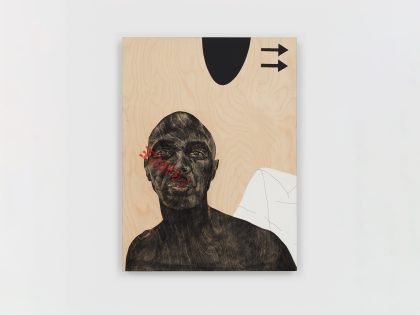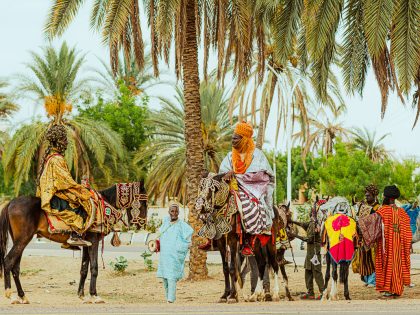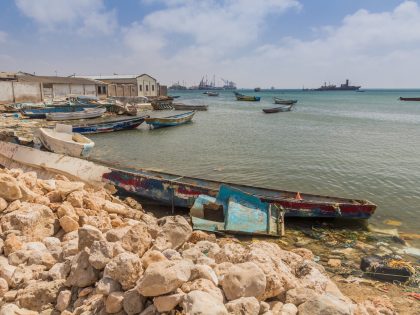The Book of Marikana
Rewriting history from below in South Africa by utilizing the voices of workers and their survivors themselves.

Police shoot at running Marikana miners.
The day after the police shot 34 miners at Marikana mine in South Africa’s North West Province, a small group of people gathered outside the gates of parliament in Cape Town. Barely 100 people, holding signs calling for answers and justice, we marched to the police station on Buitenkant, across from the District Six Museum, to deliver a petition calling for the arrest of Nathi Mthethwa, National Chief of Police. The march, for South African standards, was small and made stranger by the fact that few joined us as we passed the rush-hour crowds outside Cape Town station. Commuters looked away as they rushed to their taxis. Later that day I went to a dinner in the very-white, very-gated southern suburbs where the massacre was discussed as if it were a police briefing: a violent mob of uneducated thugs, fuelled by muti and brandishing all manner of weaponry had attacked police who responded with necessary force. A local ANC activist expressed similar sentiments to me a few days later, as he urged me not to place blame until truth had been established.
Even at that time, it seemed fairly self-evident whom to blame. Police, likely in collusion with some level of Lonmin management and possibly state officials, had called for police reinforcements following skirmishes on mine property and the refusal of miners to return to work. Video footage of the incident showed row upon row of police armed with automatic rifles peppering miners with repeated volleys as they scrambled through the veldt. The media, however, gave voice to a very different story: One of inter-union spats resulting in revenge-killings between AMCU and NUM, and, again, muti-crazed strikers hurtling spears at police. Marikana: A View from the Mountain and a Case to Answer is a necessary corrective to these accounts, giving voice to those who witnessed the massacre first hand and telling the stories of those who live with the everyday violence and poverty endemic to South African mining.
Edited by a group of Johannesburg-based academics, activists and community researchers the book will likely be the first of many dealing with the massacre and its aftermath. While it presents a much-needed alternative narrative to mainstream accounts, it ultimately fails to break any new ground or reveal facts that haven’t already been explored to some degree by reporters or through testimony at the Farlam inquiry. It proves, beyond a shadow of a doubt, that NUM, the police and Lonmin management are to blame for the slaughter. But this has already been well established by investigative coverage—most notably by South African online publication, The Daily Maverick, and foreign media outlets like Channel 4. In this sense it is something of a public shaming of mainstream South African journalists. This is not to dismiss the book’s value. The authors state quite clearly that it “can only provide a starting point for future scholarship.”
The book’s narrative weaves between the editorial voice of its writers and researchers and the first-person accounts of the massacre by strikers, their wives, and union officials. Maps of the area where the massacre took place provide much-needed illustrations of police manoeuvres in the days leading up the massacre, and validate accounts of police deliberately trapping workers. This is followed by an account of the researchers encounters with workers and their families in Marikana, and the process of building relationships of trust over short period of time and in an environment of fear and intimidation. Two researchers describe an encounter with the wife of a worker who demands to know who they are and what they are doing, claiming that people calling themselves researchers had been visiting nearby shacks kidnapping and torturing their husbands. These claims have been substantiated by reports of widespread police torture and intimidation during the Farlam inquiry. Crucially, the researchers attempt to challenge the methods of conventional ‘disinterested’ academic or journalistic research by acknowledging, and foregrounding, the pain, bravery and fear workers experienced in telling their stories. “We hope,” they write, “you can understand the massacre through the lens of the victims, those who continue to mourn the deaths of their loved ones and colleagues.”
Before the interviews with strikers and their families, there is a chronological account of the events leading up to the massacre distilled from interviews with a ‘reference group’ conducted six weeks following the event. The strength of this account lies in its exploration of worker life histories and the social conditions that led them to the shacks of Marikana. While it lacks a detailed account of poverty, it clears up the much-disputed question of mine worker wages: With few exceptions, workers took home between R4000 and R5000 ($450-R550 USD) per month. Although it is clear that workers were not only concerned with pay levels. Rock drill operators (RDOs) were made to do two jobs while only being paid for one. Interviewees also clarify that the demand for R12,500 per month was merely a bargaining chip on the table not a definite demand.
The account of the strike itself from August 9th to the 16th is remarkably consistent from one interview to another: Led by RDOs, workers marched to Lonmin offices to demand a meeting with management in order to discuss their grievances over wages and working conditions. Rebuffed by Lonmin they were told to consult their NUM officials, which they attempted to do the following day. Instead of meeting with them, NUM officials opened fire on the crowd, killing two workers and injuring dozens. Fearing further attacks from NUM the workers headed for ‘the mountain,’ from which they would plan the future of the strike. The following days saw further violence as strikers clashed with police in attempts to prevent scabs from entering the shafts. Between August 14th and 16th the strikers repeatedly requested to meet with Lonmin management in order to discuss their grievances, but management refused to negotiate directly with workers. Pleas from NUM and AMCU officials to leave the mountain and return to work went unheeded. On August 16th the area swelled with police and soldiers. Razor wire was unrolled to prevent strikers from escaping and helicopters hovered over the veldt. From worker testimony, it is clear that what ensued is nothing short of premeditated slaughter, as the majority of those killed were hunted down across the veldt. “People were not killed because they were fighting,” notes one striker, “they were killed while they were running away.”
While workers direct most of their fury at police, it is clear that they view NUM in much the same light. Prior to NUM officials firing on the strikers, workers were already convinced that NUM was not on their side as it had colluded with Lonmin in dismissing militant shaft stewards. According to one worker: “When it comes to worker’s needs, the union [NUM] makes promises but never delivers on them, and we end up losing a lot.” Worker testimony is replete with stories if NUM colluding with management to cover up unsafe working conditions and NUM officials accepting bribes from Lonmin. The decision of workers to carry ‘traditional weapons’ to the mountain was motivated out a fear of continued attacks by NUM officials rather than the police. It is no surprise then that in the wake of Marikana miners from platinum to gold to coal have registered their dissatisfaction with NUM by joining the Association of Mineworkers and Construction Union (AMCU), prompting venomous attacks from NUM and COSATU leadership.
The book concludes with a useful summary by Peter Alexander of the various smokescreens produced by the police, NUM, and the ANC alliance in order to hide their complicity in the massacre. Alexander dissects police claims of ‘self defence,’ referencing the notorious photographs that revealed police officers placing weapons beside bodies and autopsy reports showing strikers were shot in the back. Culpability, he suggests, lies within a ‘triangle of torment,’ which links the police, Lonmin and NUM and arguably extends beyond this to include the ANC and mining capital. While the leadership of SAPS is almost definitely to blame, further research will be required in order to link the incident to Zuma’s office—although Ramaphosa’s emails to Lonmin management indicate that there is much to yet be uncovered.
Perhaps most convincing an explanation is Alexander’s attempt to situate the massacre in the history of South African industrial relations. The mobilization of workers outside of formalized collective bargaining structures represented a threat, not only to industrial peace, but COSATU and NUM’s hegemony among the working class. It also threatens to erode the fragile peace the ANC negotiated with capital in the transition from apartheid. Ultimately the book is vital attempt at rewriting history from below, utilizing the voices of workers themselves. It ultimately poses more questions that answers—not entirely a bad thing—pointing toward future studies and research needed to make sense of the largest state massacre since the Soweto Uprising of 1976.



















